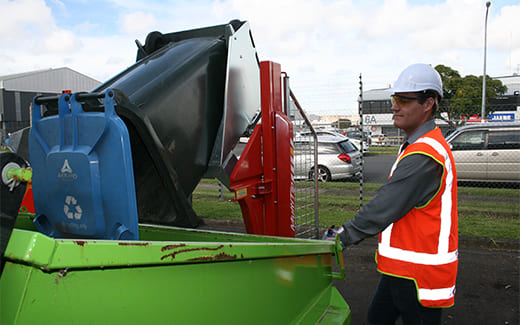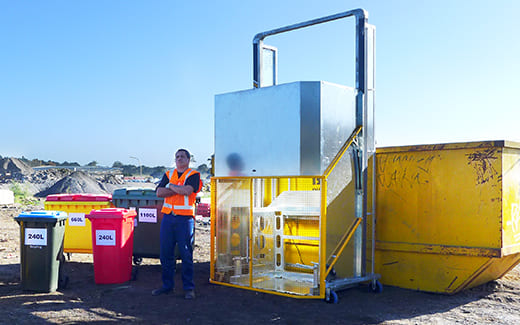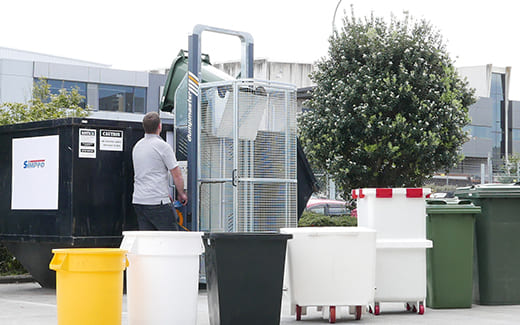Since the 1980s, local councils and waste contractors have issued guidance concerning wheelie bins for businesses and the public across the UK. The advice ranges from the size of wheelie bins you are allowed to have to the type of waste you can put in them.
Unfortunately, regardless of how careful waste collection workers are, they are always prone to injury or exposed to hazardous materials – primarily if wheelie bins collect residues and spills or if they are not regularly cleaned.
The industry uses a wide range of bins and bin lifters, and there are often incompatibilities in manufacture and design between:
- Bins
- Bin lifters
- How both are utilised
This increases the chances of accidents, seriously hurting the waste collection workers whilst working. In this article, we will study the risks they are exposed to by not handling the equipment properly, learn ways to manage these, and explore points to remember when purchasing bin lifters.
Risks of injury
Lifting is a hazard for waste collection workers. Exposed to potentially dangerous working conditions, waste collection workers are prone to lifting-related RIDDOR incidents such as hernia, back injury, or muscle ligament damage.
Mere lifting and handling courses will not eliminate the problem entirely. On the other hand, equipping them with robust and reliable bin-lifters solves the issue greatly as this reduces the manual effort and eliminates their exposure to hazardous materials.
However, there are still common bin lifting incidents, which they may encounter including:
- Getting struck by a bin falling from the bin lifter
- Becoming entangled in the bin lifter during the tipping cycle
- Injuring themselves when releasing a waste bin “hung up” on the bin lifter
- Getting struck by the bin, still attached to the bin lifter, as it returns to the ground
Risk assessment
What should be done in such scenarios? Proper training and protective gear will help. A first step, if you haven’t already undertaken one is a comprehensive risk assessment which should include risks related to:
- Flexing the bins due to excess weight
- Inadequate maintenance of the bins and bin lifters
- Moving the waste bin manually and with machinery
- Changing the order in which bins are loaded onto the bin lifter
Effective ways to manage the risk
It is pretty clear that deploying a bin lifter is not enough to mitigate all risks. Waste collection workers must know the ins and outs of using one and how to prevent a mishap before it causes any injury. Here are a few ways to manage the risk:
- Waste collection workers should take precautions before entering the lifting zone while tipping, not shake the bin with the bin lifter to release additional waste, and avoid climbing onto vehicles to remove bins “hung up” on the vehicle at the top of the tipping cycle.
- To prevent foot injuries, the distance between the ground level and the normal lowest point of the bin lifter should be at least 120 mm.
- Those operating bin lifters should be positioned safely outside the bin lifter and the bin movement zone. The equipment should be positioned to avoid operatives standing adjacent to the traffic passing by them.
- In case of an emergency, the operator should stop the bin lifter immediately and prevent automatic restart without manual resetting and having a clear view of the bin lifting zone.
- The bins used should fit safely onto the bin lifter without being manually lifted or carried.
Points to remember when purchasing bin lifters
When purchasing or replacing bin lifting equipment, it is essential to ensure the waste bins and bin lifters are fully compatible. This can be achieved by reviewing the equipment purchasing policies and relevant standards specified in tenders and contracts.
It is also possible that even though the waste bins and bin lifters are compatible, they may require precise adjustments to the lifting mechanism to ensure that the bin is held in the right place during the tipping cycle.
The bin lifter should be designed for designated waste bins and maximum bin load. The safe working load (SWL) should be displayed on the vehicle, close to the bin lifter. Automatic or semiautomatic lifting should not be allowed without interlocked barriers.
Where hopper compactors and bin lifters can operate simultaneously, there should be a way to prevent a collision between the two. For instance, any shearing or crushing hazards should be eliminated by the design of the bin lifter.
The bin lifters should be designed and built to minimise the pushing and pulling of forces required to move them. The bins should have a safe, two-handed grip when pushing, pulling, and manoeuvring them.
Smart bin lifting solutions ensure worker safety
Since 1986, Simpro has built a range of smart bin lifting solutions that enable efficient waste management. Leveraging sophisticated in-house design and fabrication capability, these bin lifters are used across establishments and industries and work with standard-sized wheelie bins.
If you are interested to learn more about the design and manufacturing details of Simpro bin lifting equipment, please contact us. We are the official European distributor for Simpro, and we would be thrilled to help you!




